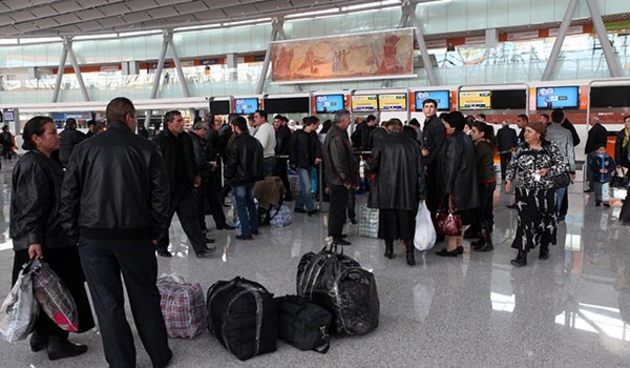Susanna Petrosyan, Yerevan. Exclusively to Vestnik Kavkaza
The socio-economic situation in Armenia continues to be extremely difficult. The number of problems associated with the exacerbation of the situation, unfortunately, is not reducing. On the contrary, today, along with other unsolved problems, there is an acute problem of a diminishing workforce.
According to some media reports that refer to the official data of the National Statistical Service of Armenia (ASCRAS), last year the number of the working-age population dropped significantly. Thus, in early 2014 the number of the employed population was 1,175,800 people, but by the end of the year the number of people employed fell to 1,111,700 persons. In fact, in a year the number of working citizens fell by 64,100 people. That is only those who have a job, and not in the overall labor force, in terms of which more significant losses were registered.
As a result of government policy aimed at promoting big business, primarily importing monopolists, it turned out to be small and medium enterprises (SMEs) that were put in a difficult situation. This manifested itself in tax pressure and high interest rates for loans to SME development, problems getting loans, AMD and others. All these difficulties are even more clearly seen in the case of small businesses, have already led to job losses and, consequently, to an increase in unemployment.
Thus, in the last year alone 667 retail kiosks were closed, while in Yerevan the number of these facilities decreased by 364 units.
According to the UN, in Armenia the average unemployment rate was 15.4% last year. This year the figure reached 17.6%. The high unemployment rate among young people aged 15-24 years, which exceeds 40%, is of particular concern. According to ASCRAS data, the most difficult situation in terms of employment is recorded in the northern parts of the country. For example, the youth unemployment rate in the second largest city of Gyumri is 52%. According to research by the Gyumri Center of Youth Initiatives, 76% of citizens consider unemployment the most important problem, while 40% plan to leave town to find work in the capital and outside Armenia. Thus, unemployment due to the government's policy, because of which small business turned out to be in the most difficult situation, becomes a reason for the migration of the population, most of whom went to look for work in Russia. Despite economic difficulties in Russia, the flow of Armenian migrants to this country has not reduced. According to statistics for 2014, 205,590 Armenian citizens went to Russia, according to the official account. For the first 4 months of 2015 the negative balance of those who left and returned to Armenia amounted to 40 thousand people.
The outflow of the working population of the country is a serious concern for experts. In particular, in Armenia today there are nearly half a million labor pensioners – about 459,000 people. This is a permanent population of more than 15.2%. In principle, this figure is low, but the trend of young people leaving Armenia does not stop. Especially now, when number of citizens from whose salaries payments are made to the pension fund is less than the number of pensioners.
In addition, the outflow of the working population as the whole migration from the country leads to a decrease in consumption of goods and services. Already in 2014 the physical volume of sales of goods in the country began to show a tendency to decrease. This year there was an additional decline in retail turnover in current prices. According to economics expert Vahagn Khachatryan, the decline in purchasing power of the population and the reduction in their number shows such important indicators as turnover reduced by 6% and energy consumption reduced by 18%. Among other important indicators of solvency and reduction of the population is a reduction in food production, as well as the reduction of their imports by nearly a quarter.
Thus, the outflow of the population, caused by the incompetent policies of the authorities, leading to a reduction in consumption, production and import of goods, a reduction in consumption of electricity and gas, as well as a decrease in the number of other indicators related to economic growth. According to ASCRAS, in January-March 2015 the foreign trade turnover in comparison with the same period last year decreased by 28.5%, while exports fell by 23%.
Despite the really difficult situation, the government continues to make optimistic statements. Recently, Prime Minister Ovik Abrahamyan said that this year in the Armenian economy economic growth of one percent will be recorded (note: the IMF forecasts GDP growth in Armenia will be 0%), which is 4 times less than the figure provided by the state budget for 2015. Meanwhile, the prime minister then added that, in his personal opinion, economic growth will exceed 1%.
According to the economic observer of the Armenian Times newspaper, Ayk Gevorgyan, mere statements about GDP growth are not enough; in parallel, it is necessary to point to other indicators, compared with which it can be understood, due to what growth is recorded. "In fact, it is difficult to imagine a situation where investments in the economy are reduced, but the economy is growing," Gevorgyan says.
As a result of the reluctance of the government to change the emphasis in the existing policies in the socio-economic sphere of the country, a vicious circle has formed. In particular, excessive pressure on SMBs, and even the destruction of small businesses by the authorities, have led to an increase in unemployment and migration. Accordingly, the reduction in the workforce and population in general leads to new problems, such as reducing the consumption of goods and services and other indicators that have a negative impact on economic growth. The fact remains that we need major changes, and the continuing upbeat statements by the authorities in no way influence the solutions to many problems.






